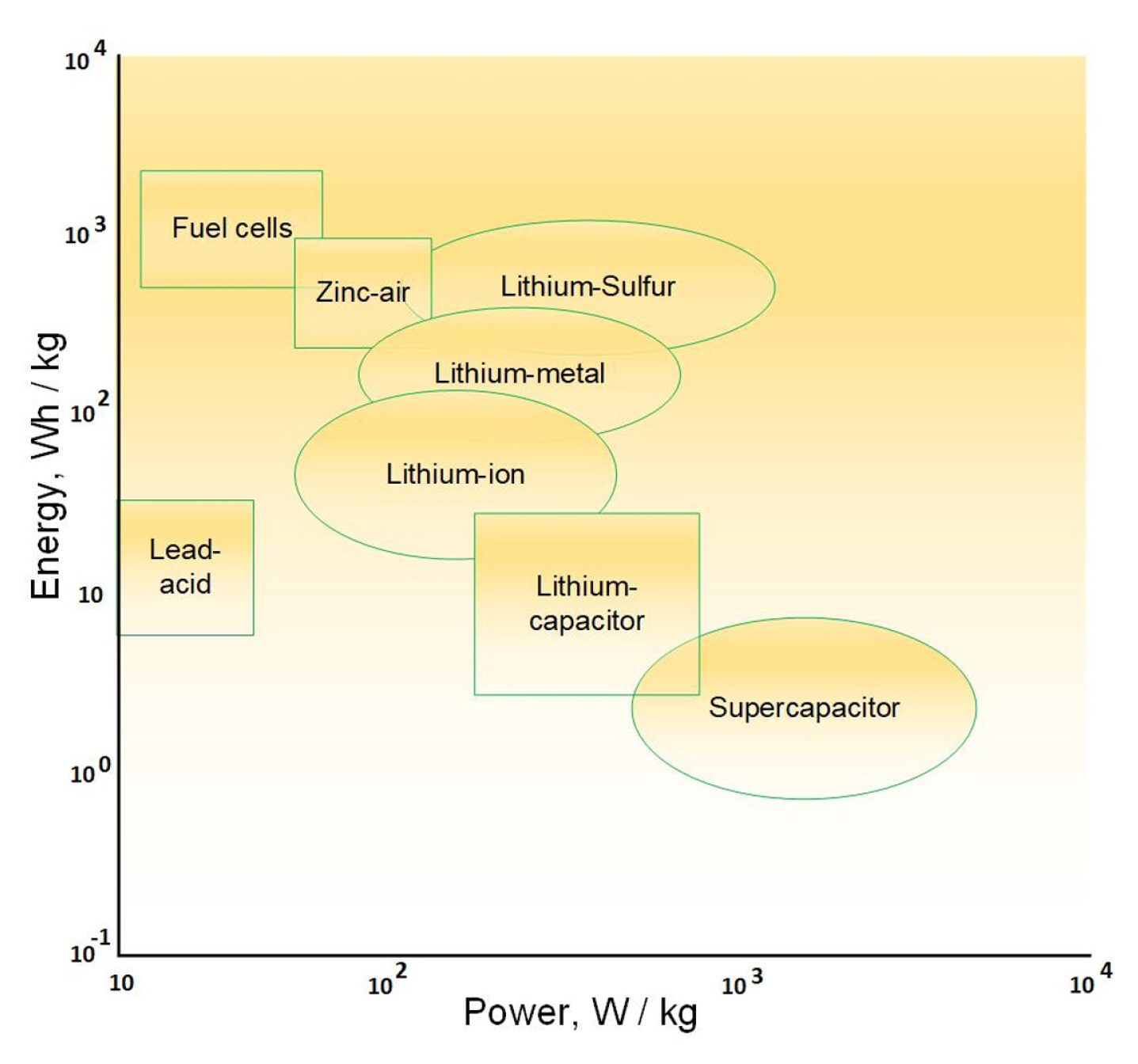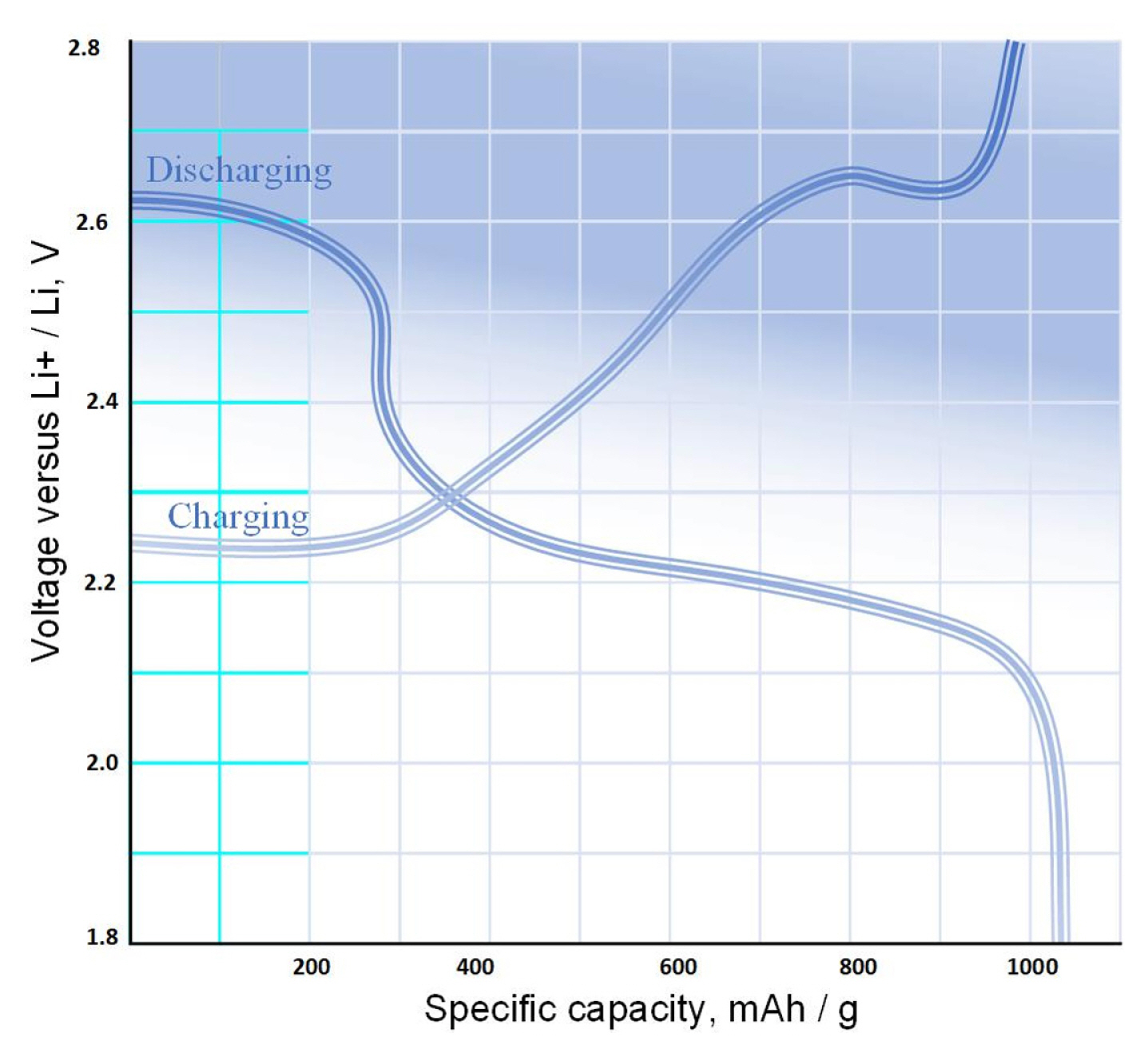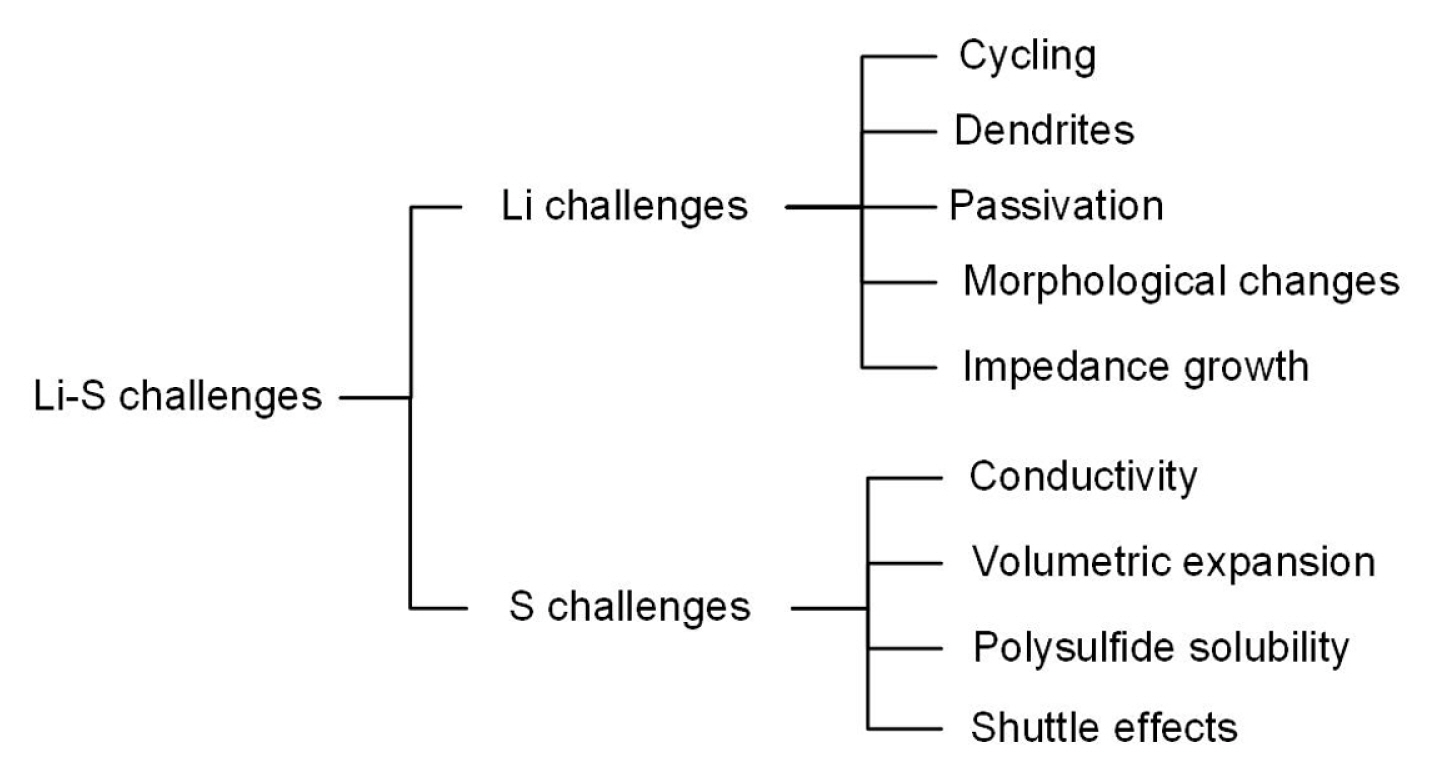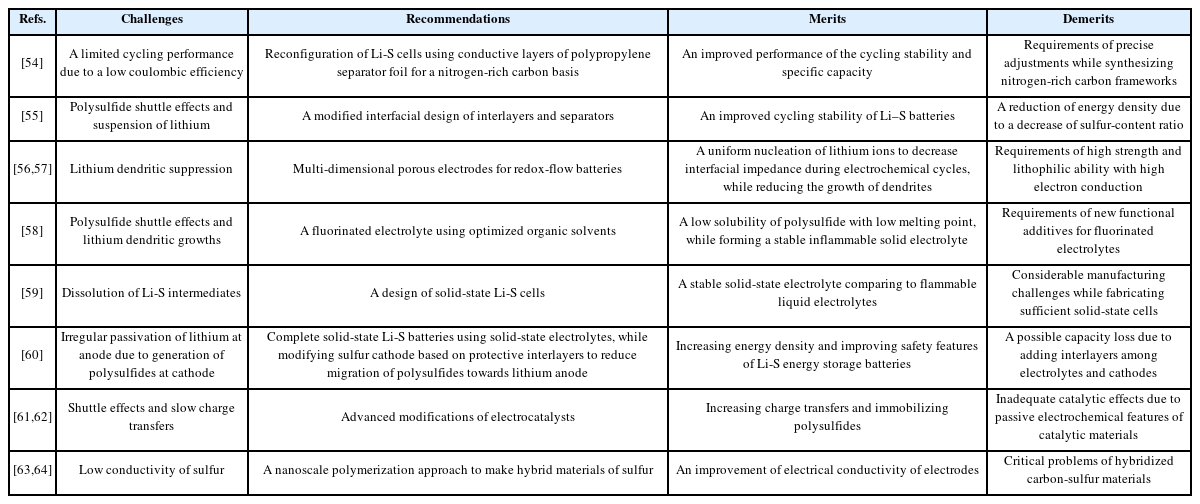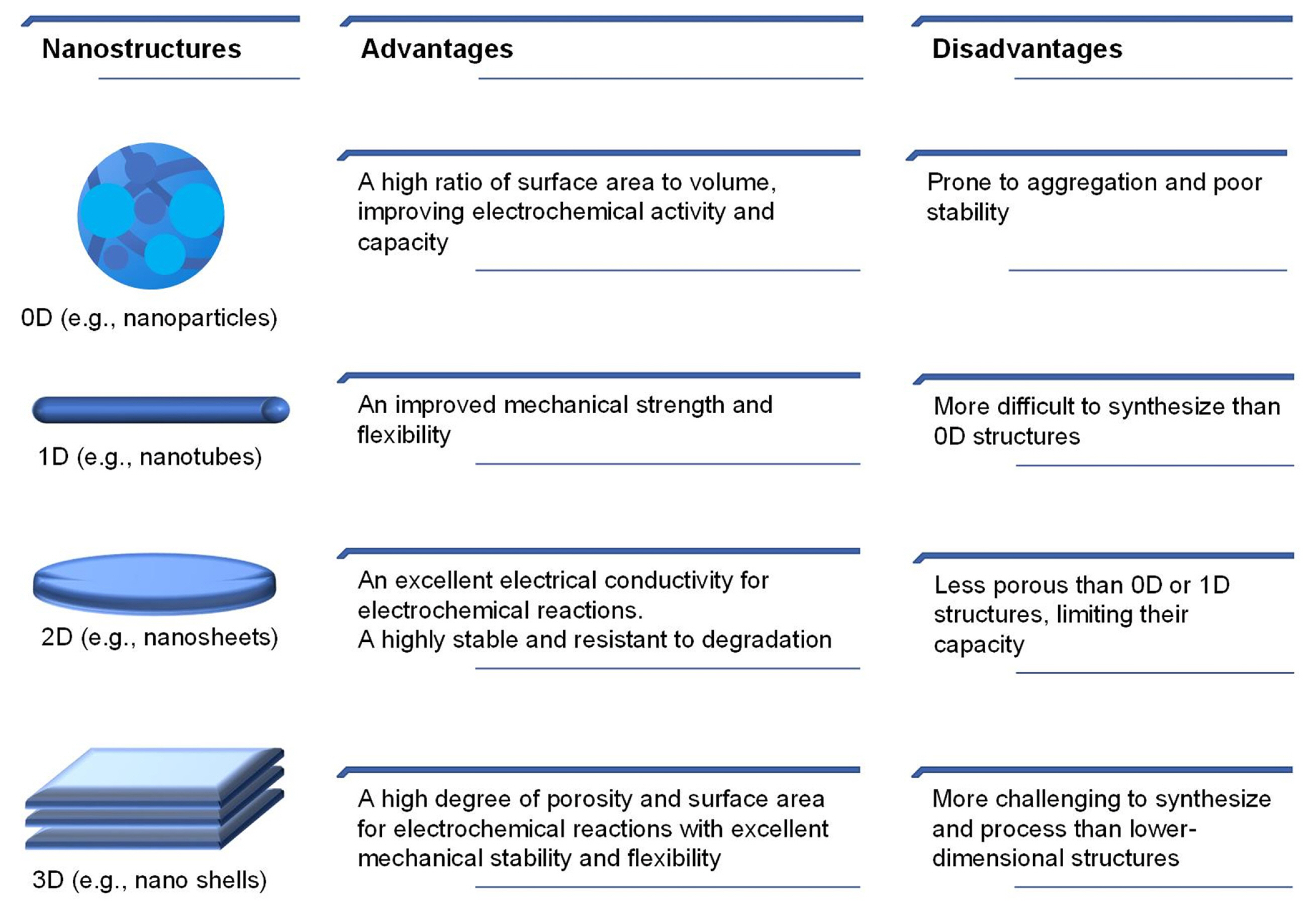Applications and Challenges of Lithium-Sulfur Electrochemical Batteries
Article information
Abstract
This paper presents applications of lithium-sulfur (Li-S) energy storage batteries, while showing merits and demerits of several techniques to mitigate their electrochemical challenges. Unmanned aerial vehicles, electric cars, and grid-scale energy storage systems represent main applications of Li-S batteries due to their low cost, high specific capacity, and light weight. However, polysulfide shuttle effects, low conductivities, and low coulombic efficiencies signify key challenges of Li-S batteries, causing high volumetric changes, dendritic growths, and limited cycling performances. Solid-state electrolytes, interfacial interlayers, and electrocatalysts denote promising methods to mitigate such challenges. Moreover, nanomaterials have capability to improve kinetic reactions of Li-S batteries based on several properties of nanoparticles to immobilize sulfur in cathodes, stabilizing lithium in anodes while controlling volumetric growths. Li-S energy storage technologies are able to satisfy requirements of future markets for advanced rechargeable batteries with high-power densities and low costs, considering environmentally friendly systems based on renewable energy sources.
1. Introduction
Rechargeable batteries have technically developed to lithium-ion (Li-ion) technologies based on lead-acid ones since they were invented in 1859 [1]. Innovative developments of Li-ion batteries have occurred over the period of 1970s–1980s. In the late 1970s, rechargeable batteries were presented by considering electrodes of lithium metal and titanium disulfide. However, such types of batteries have led to several safety concerns. In the 1980s, a cathode of lithium cobalt oxide was designed while introducing an anode of lithium graphite. Subsequently, prototypes of Li-ion batteries were developed in 1985, commercializing them in 1991. Afterward, many corporations in China, Korea, and Japan have concentrated on advancing the technology needed to produce next-generation batteries. Li-ion batteries have succeeded in the market for different uses such as electric vehicles (EVs), wind/solar energy storage systems, and portable gadgets [1,2].
Lithium-sulfur (Li-S) cells are a promising alternative to traditional Li-ion batteries due to their high theoretical energy density and low cost. However, the practical implementation of Li-S cells is limited by several challenges, including poor cycle life, low-rate capability, and safety concerns. The mechanism of Li-S cells involves several electrochemical reactions that occur during charging and discharging cycles. During discharge, lithium ions (Li+) migrate from the anode (i.e., lithium metal or graphite) through the electrolyte (i.e., liquid or solid-state electrolyte) and react with sulfur (S) at the cathode to form lithium sulfide (Li2S). The electrons released during this reaction flow through an external circuit, generating electrical energy. The lithium sulfide formed at the cathode is insoluble in most electrolytes, which leads to the formation of a solid layer on the cathode surface. The layer of solid-electrolyte interphase (SEI) limits the transport of lithium ions and reduces the cell’s capacity. During charging, the reverse reaction occurs by extracting lithium ions from the lithium sulfide at the cathode to migrate back to the anode. The sulfur is oxidized to form polysulfides, which dissolve in the electrolyte. The polysulfides can diffuse through the electrolyte and react with lithium ions at the anode to form lithium sulfide and sulfur. The sulfur produced in charging process is able to dissolve in the electrolyte and diffuse back to the cathode during discharge, leading to a phenomenon known as shuttle effect. The shuttle effect causes capacity loss and reduces the cycle life of Li-S cells [2–5].
The polysulfide shuttle effect represents a significant barrier to the practical implementation of Li-S batteries [4]. The migration of polysulfide towards the side of the lithium anode is able to produce long-chain polysulfide due to its dissolution into the electrolyte [5]. Moreover, Li-S batteries are constrained by the low conductivity of sulfur and the significant change of volume. Electrochemical characteristics of Li-S batteries are demonstrated in Ref. [6], while investigating both liquid and solid electrolytes. A review is presented in Ref. [7] to highlight technical problems of sulfur in electrolytes.
To mitigate the shuttle effect and improve the performance of Li-S cells, several strategies have been proposed in the literature [8–11], including the use of high-capacity cathode materials, electrolyte additives, and protective layers. However, the development of practical Li-S cells with high energy density and long cycle life remains a challenge. Multi-dimensional nanomaterials of different layers have a potential to overcome such challenges of Li-S batteries, considering their particular architectures and physical/chemical properties [8]. A separator of multifunctional composite was proposed in Ref. [9] to improve the reversibility and cycle stability of Li-S batteries. Separators in Li-S batteries are able to add blocking layers between the cathode and anode to suppress the diffusion of lithium polysulfides [10]. Additionally, several layers are utilized in Li-S energy storage batteries to buffer volumetric changes, while suppressing lithium dendrites [11].
In recent years, electrochemical Li-S batteries have received an interest in both academia and industry. Fig. 1 shows numbers of publications dealing with lithium sulfur electrochemical batteries over the period of 2000–2022. The development of Li-S batteries will lead to more affordable and lighter systems with improved safety features. Li-S technologies have the potential to be utilized in electric aircraft for short-range travels, while considering other uses in satellites, drones, and military vehicles [12,13].

An estimate of numbers of publications for each year based on Google Scholar databases using words of lithium sulfur electrochemical batteries.
This paper contributes to the existing literature as follows.
It presents main applications of Li-S energy storage batteries, while discussing key challenges (e.g., inadequate cycling performance in lithium anodes) and (e.g., low electrical conductivity in sulfur cathodes).
It shows pioneering strategies to mitigate key challenges of Li-S batteries, considering their tradeoffs while deliberating nanotechnologies in electrochemistry.
It demonstrates future markets of Li-S energy storage batteries based on their remarkable theoretical capacities and low costs to meet rising demand for green energy brought by environmental concerns.
2. Applications of lithium-sulfur batteries
Unmanned aerial vehicles that are able to hover for extended periods of time at high altitudes are the most popular applications of Li-S batteries. Unmanned aerial vehicles use solar panels to power their propulsion systems, while they are in the stratosphere. Energy storage systems of these aerial vehicles should keep them in the air for days, weeks, or even months. Accordingly, they need light batteries for their systems in order to enable them to stay in the air for a longer period of time. As a result, unmanned aerial vehicles have capability to use Li-S batteries based on their light-weight properties comparing to other electrochemical energy storage technologies [14].
Low costs of Li-S batteries are relatively assured because sulfur is the superfluous of the petroleum industry. Therefore, such batteries are competitive amongst next generation of energy storage systems. Nevertheless, several challenges (e.g., high volume change and low electrical conductivity) of the sulfur cathode led to low utilization of such batteries in practical applications [15]. Over the past decade, technical developments have been accomplished to improve the performance of Li-S batteries by addressing their challenges, proposing feasible approaches for future research directions [16]. Before moving from laboratory scale to industrial production and eventually to market distribution, each new battery technology must first undergo rigorous research and testing. Li-S batteries were not made commercially accessible on the market, but they will be commercially available in electric vehicles, smartphones, and smart grids. Batteries are playing a role in an energy-ecological development through their increased uses, ranging from electric vehicles to grid-scale energy storage systems. Batteries are efficient stationary storage technologies because they are able to enhance energy efficiency of end-user premises, while achieving operational improvements and financial savings [17–20].
The use of fossil fuels in road transportation will decrease when internal combustion engines are replaced by electric vehicles, reducing greenhouse gas emissions. Furthermore, batteries have an impact on renewable energy markets and they are very important for connecting solar and wind energy (i.e., due to their variable and intermittent nature) to the grid. Notably, advances in battery technology are crucial to both the electrification of road vehicles and grid-scale energy storage systems [21]. For example, Li-S batteries have capability to be employed in electricity networks as grid-connected energy storage devices based on various applications (e.g., peak shaving and load leveling), considering frameworks of different system operators [22]. Key stages of modern power systems include planning and operation of microgrids with the integration of renewable energy sources. The use of sophisticated energy storage batteries is required to cover important aspects in microgrids with high penetrations of electric vehicles and renewable resources [23–27]. Due to the ongoing depletion of nonrenewable resources, clean energy and energy-storage technologies, particularly batteries, have become essential. The management of battery technology is now vital due to the oil crisis and high levels of pollution. High quantities of power are needed for operating a variety of electrical gadgets [28]. Due to their high energy density and high specific capacity, Li-ion and Li-S cells have been considered as potential compositions for the most popular energy storage systems. However, significant flaws still remain, including the expensive price of lithium and inadequate conductivity of sulfur. To address the aforementioned issues, recent developments in the preparation techniques and geometric designs for improving electrochemical performances are presented in Ref. [29]. Li-S batteries have capability to obtain additional Wh/kg as shown in Fig. 2 [30–33], comparing to other lithium energy storage technologies.
3. Challenges of lithium-sulfur batteries
The operating principle of a Li-S cell is demonstrated in Fig. 3 [14], as follows. The anode of the Li-S cell consists of lithium, whereas its cathode includes sulfur with carbon-based materials and binders [34]. The anode of the Li-S cell is separated from the cathode using a polymer with an organic-solvent electrolyte [14,35], providing possibility to convey electrons and lithium ions in ambient temperatures. Charging and discharging curves of a Li-S battery [31] are demonstrated in Fig. 4 [31,36,37], in which the electric energy is kept in the cathode of sulfur. Hence, the discharging process commences by oxidizing Li metal at the anode to produce Li-ions and electrons, transporting Li-ions to the cathode throughout the separator. Meanwhile, the electrons reach the end side of cathode with an external electric circuit as shown in Fig. 3 [14]. Accordingly, sulfur is decreased to generate Li2S by assuming electrons and Li-ions at the cathode, considering two-electron procedures [31]. Additional details on the charge and discharge profiles of Li-S batteries are presented in Refs. [8,14,45,36,38–44].
Li-ion batteries with insertion cathodes have improved over the past two decades to reach energy density of 800 Wh/kg [2]. Although Li-S batteries have a theoretical energy density of about 2600 Wh/kg [2,39], their electrochemical processes cause sulfur to go through a number of compositional and structural modifications involving both soluble polysulfides and insoluble sulfides. As a result, scientists have had difficulty maintaining a stable electrode structure, making full use of the active material, and achieving an adequate cycle life with high system efficiency. Although research on rechargeable Li-S batteries has advanced significantly over the past, cycle life and efficiency problems prevent their use in commercial cells [2]. Even before lithium-ion (Li-ion) rechargeable batteries were invented, research on Li-S batteries began in the early 1960s. But only a few years ago did the subject regain its significance, and since then, the literature has been overwhelmed with numerous study and development contributions. Outstanding cycling achievements were made at the laboratory scale, indicating that the field is undoubtedly developing. Nevertheless, the biggest problem with the Li-S system at the moment is the requirement to use more electrolyte than necessary in order to get decent cycling results [46]. According to Refs. [47,48], main challenges for Li-S cathodes are fast capacity fading, volumetric expansion, and poor electrical conduction. The need for lithium batteries is urgent as a result of the recent rapid growth in different energy sectors. As a highly competitive battery, Li-S electrochemical technologies have an energy density greater than conventional lithium systems. However, other functional improvements of Li-S batteries are required to enhance their efficiencies and industrial applications due to their limits in the reaction process. The benefits and drawbacks of Li-S batteries are discussed in Ref. [49], while providing an overview of their structure-based materials and upcoming difficulties. Fig. 5 shows key challenges of Li-S batteries [2,7,42,44,50].
Therefore, considerable challenges remain in front of the commercialization of Li-S batteries, including high-volume changing in sulfur cathodes during electrochemical processes, lithium dendrite problems, and uncontrolled shuttle effects of polysulfides. Researchers will require innovative Li-S designs and sulfur composite cathodes with reasonable characteristics to solve these issues. For example, Ref. [36] proposes solid-state electrolytes to resolve issues of Li-S batteries, while summarizing current developments in such technologies. Fundamentals of Li-S solid-state batteries are also provided in Ref. [36], considering polymer, inorganic and hybrid solid-state electrolytes. However, the commercialization of solid-state Li-S batteries is constrained by low ionic conductivity, poor interfacial contact, and relatively small electrochemical window of solid-state electrolytes. Hence, advantages and disadvantages of various types of electrolyte with typical coping mechanisms and operating patterns are discussed in Ref. [51]. Furthermore, the formation of innovative composite of cathode materials, such as composites of sulfur with carbon and sulfur with polymer, are proposed in Ref. [2] to enhance physical characteristics and electrochemical performances. In addition, strategic arrangements of utilizing carbon interlayers and Li-dissolved polysulfide cells are given in Ref. [2] to improve maintenance and effectiveness of Li-S technology toward widespread adoption. Due to superior capacity of sulfurized polyacrylonitrile (SPAN) to entirely eliminate the shuttle of lithium polysulfides comparing to elemental sulfur cathodes, SPAN technologies are recognized as a substitute sulfur cathode for practical applications in Li-S batteries. To offer insight on SPAN applications in commercial manufacturing in the future, possibilities and challenges are examined in Ref. [52], while reviewing the current advances in developing such material for the use in Li-S batteries.
4. Mitigating challenges of lithium-sulfur batteries
It seems uncertain that Li-S energy storage batteries will be commercialized until the gap between real-world situations and academic research are linked. Lithium polysulfide and sulfur have insulating properties. Sulfur has capability to be an insulating material with very low conductivity. Polysulfide shuttle represents another problem with Li-S batteries, developing a lengthy polysulfide chain due to elemental sulfur ring structure. The electrolyte dissolves the polysulfide chains, which then diffuse from the cathode to the anode. At the anode, the polysulfide reacts chemically with the lithium metal to create a shorter polysulfide chain, causing a fast capacity decline. The other issue signifies recurrent volume expansion and contraction during charge and discharge operations. During the redox process, each sulfur atom receives two lithium ions, causing varying densities due to different sulfur elements. The development of a sulfur cathode based on graphene has a promising application in Li-S energy storage batteries. The most significant obstacles to commercialize such batteries are capability to be the low electrical conductivity of elemental sulfur at room temperature, while considering high volume fluctuation [43].
Lithium anodes suffer from low coulombic efficiency and dendritic growth with high volume changes during repeated cycles, leading to pulverization and expansion of the pouch case. This can cause unexpected failure and serious safety problems of Li-S batteries. To overcome such challenges, coating layers are able to buffer volumetric changes, while suppressing lithium dendrites to improve safety features [11]. Furthermore, cell controllers and battery management systems are required to increase reliability and safety of Li-S batteries [10]. Sulfur cathodes suffer from a low electrical conductivity, high volume change, and polysulfide shuttle effect, deteriorating cathode active materials of Li-S batteries. Different types of interlayers (i.e., insertion of membranes amid separators and cathodes) have capability to mitigate such challenges of Li-S cathodes [15]. However, a high specific surface area of interlayer materials reduces the overall energy density of Li-S cells. Therefore, enhancing mass loading of sulfur are able to increase pouch cell capacity for competitive energy density of Li-S batteries [10]. Moreover, the energy density of Li-S batteries is determined based on electrolytes (i.e., ionic liquids or solid composites). Ionic liquid electrolytes are used in Li-S batteries to provide high conductivity, high thermal stability, and nonvolatility. A mathematical model is presented in Ref. [53] to evaluate a practical volumetric energy density of Li-S batteries to reduce inactive additives in cathode, decreasing the porosity of electrodes while balancing loading and utilization of sulfur in such electrochemical storage technologies. Meanwhile, solid electrolytes (e.g., solid polymers, gels, and organic-inorganic composites) are utilized in Li-S batteries to offer a broader electrochemical range, higher ionic conductivity, and better chemical stability. In the meantime, separators are used in Li-S energy storage batteries to add a blocking layer between the cathode and anode to enhance ion selectivity, while suppressing the diffusion of lithium polysulfides [10]. Table 1 shows recommendations to mitigate challenges of Li-S energy storage batteries, while showing merits and demerits of such techniques.
5. Nanomaterials in lithium-sulfur batteries
Li-S batteries typically consist of a cathode, an anode, and an electrolyte. The cathode is usually made of sulfur or a sulfur-based compound, while the anode is made of lithium metal or graphite. The electrolyte can be a liquid or solid-state material that facilitates the movement of lithium ions between the cathode and anode. The morphology of Li-S batteries can vary depending on the specific design and application. Some Li-S batteries may have a cylindrical shape, similar to traditional lithium-ion batteries, while others may have a flat, thin-film structure for use in flexible electronics. In terms of composition, Li-S batteries may include additional components such as conductive additives, binders, and separators to improve their performance and stability. Protective coatings may also be applied to the cathode to prevent the formation of the solid-electrolyte interphase (SEI) layer, which can limit the transport of lithium ions and reduce the cell’s capacity. The structure, composition, and morphology of Li-S batteries are critical factors that determine their energy storage capabilities and practical implementation. Ongoing research and development efforts are focused on improving these aspects to enable the widespread adoption of Li-S batteries as a viable alternative to traditional lithium-ion batteries. Over the last 30 years, several studies were presented to design and synthesize monodisperse nanomaterials for various applications. A distinctive feature of such studies is to classify the dimensionality of nanomaterials, considering zero-dimension (i.e., 0D nanoparticles), one-dimension (e.g., 1D nanotubes), two-dimension (e.g., 2D nanofilms and nanolayers), and three-dimension (i.e., 3D nanostructures), as shown in Fig. 6. Nano-science has created new opportunities for the study of Li rechargeable batteries, by improving the characteristics of materials and enabling novel chemistries [65]. 0D, 1D, 2D, and 3D nanostructures have unique advantages and disadvantages that affect their performance as energy storage materials as demonstrated in Fig. 6 [65–68]. Applications of nanotechnologies for energy storage technologies depend on performance characteristics, while synthesizing them based on porous carbon nanostructures.
Nanomaterials of several layers are able to overcome challenges of Li-S batteries, considering their specific architectures and chemical properties [8]. For example, a separator of multifunctional composite was proposed in Ref. [9] to improve the reversibility and cycle stability of Li-S batteries, adding blocking layers between the cathode and anode to suppress the diffusion of lithium polysulfides. Lithium-metal batteries have capability to provide high energy density comparing to other electrochemical storage technologies. However, it is challenging to employ such metal anodes in real-world applications due to infinite volume changes and unstable solid electrolytes [69]. Furthermore, frequent plating and stripping can cause dendritic and irreversible lithium, resulting in interior short-circuits and capacity fading. Commercial batteries of lithium-metal anodes require a strategy to overcome these challenges as they cause safety concerns and failure mechanisms [70]. Therefore, a comprehensive review is presented in Ref. [70] to demonstrate three-dimensional structured electrodes and interfacial layers between the electrolyte and electrode, while employing them as host materials to achieve a practical strategy for lithium-metal storage technologies. In addition, porous carbon compounds were suggested in Ref. [70] as host materials based on zeolitic imidazolate frameworks due to their advantageous qualities, highlighting uses of host materials for practical lithium-metal batteries [70]. Moreover, lithium-metal hosts of lithophilic surfaces are proposed in Ref. [71] using nanomaterials to prevent irreversible lithium, improving electrochemical performance while achieving stable long-term cyclability of such rechargeable batteries. The fundamentals of morphological control of nanomaterials are examined in Ref. [65] based on tradeoffs of various morphologies, considering difficulties of nanomaterial-based batteries and their possibilities for commercialization. A systematic survey of computational simulations has been addressed in Ref. [72] to study fundamental aspects in molecular or atomic levels, while considering nanostructured materials at the nanoscale.
Operational features of Li-S batteries have been significantly improved by a wide range of carbon nanomaterials with several properties. Physical and chemical characteristics of nanomaterials are able to immobilize sulfur in cathodes, stabilizing lithium in anodes while accommodating volumetric growths to improve kinetic reactions [38]. Carbon nanoparticles have capability to transform the development of research in Li-S batteries. The generation of hybrid cathodes using sulfur and carbon has been the primary use of diverse carbonate nanostructures. It has been shown that carbon nanomaterials play a variety of functions for determining conduct of electrochemistry of Li-S battery cathodes. Developments of sulfur in micropores and volume expansion in mesopores were all made possible by the tunable porosity of carbon nanomaterials. Carbonaceous resources were employed for making high-performance cathode materials [73]. However, the primary issues that still need to be resolved are their distinct electrochemical behavior involving the generation of dissolved polysulfide intermediate species and the insulating properties of sulfur. Several approaches are able to improve performance of Li-S, including suitable cathode architectural design, electrolyte optimization, and lithium metal stabilization. A high sulfur content, high sulfur loading, and high electrolyte-to-sulfur ratio have recently emerged as significant obstacles to the commercialization of Li-S batteries. Different studies were reviewed in Ref. [74] to show the development of structural and functional nanomaterials for Li-S batteries, proposing recommendations for further considerations. Furthermore, the fundamental problems with Li-S batteries can be solved by two-dimensional (2D) materials with monolayers or few layers since they often have unusual architectures and physical/chemical properties. In particular, metal-based 2D nanomaterials, such as cobalt, can offer strong conductivity and a sizable surface area to slow down the diffusion of lithium polysulfides. The shuttle of polysulfides is the primary bottleneck for the Li-S energy storage batteries. Hence, a review has been presented in Ref. [8] to address relevant prospects and challenges.
Li-S batteries have not yet achieved commercialization because of low loading density of sulfur due to its poor electrical conductivity. The polysulfide shuttle phenomenon and sulfur natural ability to act as an insulator are the major causes of these problems [75]. Nanotechnology has been used to create porous carbon nanocomposites, hollow one-dimensional carbon nanomaterials, graphene nanocomposites, and three-dimensional carbon nanostructured matrices in an effort to find solutions of such problems. Several approaches were evaluated in Ref. [39] relating to the use of nanotechnology in the synthesis of sophisticated and high-performance Li-S batteries. As mentioned earlier, Li-S batteries suffer from significant drawbacks, such as the naturally low conductivity of sulfur, the high-volume changes of sulfur cathodes, unfavorable shuttling, and the slow redox kinetics of polysulfides. Therefore, iron-based nanomaterials are suggested in Ref. [40] for efficient synergistic immobilization as well as for accelerating polysulfide conversion reaction kinetics. Accordingly, a summary of the mechanisms between various iron-based nanomaterials and polysulfides for entrapment and convergence acceleration was provided in Ref. [40], while reviewing current developments in using different iron-based nanomaterials as sulfur hosts, separators, and cathode interlayers in Li-S batteries. Rechargeable Li-S batteries continue to be the most promising platform for reversibly storing significant amounts of electrical energy at a modest cost constrained by the underlying cell chemistry among the numerous electrochemical energy storage technologies. The issues of Li-S batteries seem to be well suited for novel nanomaterial-based solutions and for fundamental solutions supported by tools of nanotechnology [76]. Improvements in nano-characterization and theoretical investigations of the Li-S system were presented in Ref. [77], starting with a review of understanding chemistry and operation of Li-S batteries. Inabilities of Li-S cells to perform their theoretical potentials were explored in Ref. [77], considering recent developments in cathode and in cell design using nanomaterials.
6. Future markets of lithium-sulfur batteries
Future markets of Li-S batteries will depend on advancements in both cycling performance and power density of such energy storage technologies. It is expected to evolve Li-S cells with either enhanced cycle life or improved power density because the majority of academic research is concentrated on creating a single component of these batteries (electrolyte, cathode, or anode) rather than a complete unit [14]. The formation of batteries with high energy density is crucial based on the rising demand for green energy brought by environmental concerns. Since their significant development in 2009, Li-S batteries have received an interest from both academic and industrial establishments. Using a variety of cutting-edge techniques, the academic community has achieved substantial developments in enhancing the performance of cycling efficiencies and particular capacities. However, when similar strategies are used in mass production, the results are different, highlighting a substantial distinction between academic research and industrial production [78]. Li-S chemistry is one of the most commercially developed technologies of next-generation batteries, providing a significant improvement in energy density [79]. However, there are still unresolved challenges that must be addressed in order to improve the performance of Li-S cells in order to initiate their commercial prospects. A roadmap is presented in Ref. [79] to serve as a guide for academic, commercial, and governmental organizations to support the growth of Li-S research communities. The literature [80] shows methods to enhance the storage systems taken by different countries, updating their electric power networks and incorporating renewable energy sources. A precise focus has been addressed in Ref. [80] on batteries in electric power grids to estimate incentives of energy storage markets. It is determined that battery prices are dropping more quickly than was previously thought. Predictive analytics and emerging digital techniques (e.g., artificial intelligence) have capability to develop integrated solutions and cutting-edge business models of batteries to be commercialized for the benefit of electricity consumers, utilities, and grid operators [80]. A rapid dissemination of innovative ideas at the prototype cell level is crucial for the commercialization of Li-S energy storage batteries. Furthermore, basic research should focus on fundamental scientific issues pertaining to primary Li-S cell bottlenecks, comprehending anode and electrolyte degradation mechanisms and practical assessment of stabilizing interfaces [50,81,82]. Advanced rechargeable batteries of high-power densities and low costs represent an urgent need, while considering environmentally friendly systems and high energy storage applications. Li-S batteries have the potential to satisfy the needs of such systems because of their high theoretical capacity and cheap cost. However, the poor cycle stability, low round-trip efficiency, and severe self-discharging rate (i.e., caused by the dissolution of long-chain polysulfide and their interactions with Li metal anode) have made the difficulty of Li-S batteries to gain market share [83]. The compatibility of power sources will be improved through the application of nanotechnology to the research and manufacture of Li-S batteries. Such market will expand as a result of rising uptakes of electrical vehicles and renewable energy sources. Batteries powered by Li-S nanotechnology have a greater energy density than conventional Li-ion batteries. Thus, the growth of Li-S batteries market will be accelerated by the application of nanomaterials throughout the anticipated time from 2021 to 2026 [84]. Due to the pressing demand for better electric storage technologies for environmentally friendly transportation and high energy storage applications, Li-S battery technology has undergone a thorough review. However, commercial uptakes of Li-S batteries have been delayed considering the gap between fundamental research and actual needs [44]. Li-S batteries must be made in a method that stabilizes Li deposition, while improving cycling in order to be commercially feasible [85]. Because of their huge energy capacity, Li-S systems are one of the most promising contenders for the next generation of energy storage systems. In order to promote such commercialization, enormous work has been put into resolving their inherent issues. Practical obstacles of Li-S cells are outlined in Ref. [81] in order to maintain their energy density and long-term cycling, while emphasizing methods of enhancing their performance based on materials and structures of cathode, anode, electrode, and electrolyte. Although Li-S batteries have made remarkable paces in their development, extra evaluations are needed to study the crucial factors that influence their energy density. Therefore, a formulation for energy density calculations is suggested in Ref. [86] based on important factors, such as sulfur mass loading, sulfur mass ratio, electrolyte-sulfur ratio, and negative-to-positive electrode material ratio. In addition, future research possibilities, aims and directions for designing practical high-performance Li–S batteries are proposed in Refs. [86,87]. Fig. 7 shows an estimate of the market size of Li-S electrochemical batteries based on [84,88] databases.
7. Conclusions and outlooks
This study has presented a survey on key applications and challenges of lithium-sulfur (Li-S) batteries, reviewing main strategies of mitigation while showing uses of nanomaterials in such energy storage technologies. Applications of Li-S batteries have been demonstrated to underpin sustainable energy technologies, ranging from electric vehicles to grid-scale energy storage systems. Several challenges restrict the commercialization of Li-S batteries, including volumetric changes of sulfur cathodes, dendritic problems of lithium anodes, and shuttle effects of polysulfides. These issues have capability to reduce cycling performances of Li-S energy storage batteries, while decreasing their safety features.
Technical problems of Li-S batteries can be resolved using different strategies such as: modified interlays, nanomaterials. organic and solid-state electrolytes. Modified interlays are relatively inexpensive approach to improve the stability and capacity of Li-S batteries by providing an added surface area for sulfur deposition. However, they increase the internal resistance of Li-S batteries. In the meantime, applications of nanomaterials are able to improve stability, capacity, and conductivity of Li-S batteries. Nevertheless, nanostructures of porous carbon are typically more expensive than traditional carbon materials. Although organic and solid-state electrolytes are less flammable and more stable than traditional liquid electrolytes, such electrolytes are typically expensive.
The future of Li-S batteries looks promising, with the potential to overcome the limitations of current lithium-ion batteries. However, there are still challenges to overcome, such as limited effectiveness and higher costs associated with some approaches to mitigate technical challenges of Li-S batteries. Future research will need to focus on optimizing these technologies to make them more efficient and cost-effective. Moreover, there is a need for standardization in Li-S battery design and manufacturing processes to ensure consistency and reliability. Although the gap between academic research and industrial production has an impact on the commercialization of Li-S batteries, pressing requirements of renewable energy sources and high-power storage applications will increase their uptakes.
Notes
Conflict of interests
The author declares no conflict of interests.
